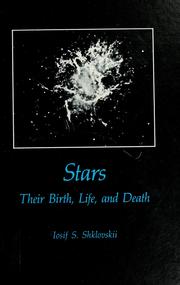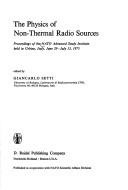| Listing 1 - 10 of 23 | << page >> |
Sort by
|
Book
ISBN: 9003909601 9789003909602 Year: 1972 Publisher: Zutphen Thieme
Abstract | Keywords | Export | Availability | Bookmark
 Loading...
Loading...Choose an application
- Reference Manager
- EndNote
- RefWorks (Direct export to RefWorks)
524.3 --- Stars --- 524.3 Stars
Book
ISBN: 3540063765 0387063765 3540469834 9783540063766 Year: 1973 Volume: 69 Publisher: Berlin Springer
Abstract | Keywords | Export | Availability | Bookmark
 Loading...
Loading...Choose an application
- Reference Manager
- EndNote
- RefWorks (Direct export to RefWorks)
Physics --- 524.3 --- Stars --- Black holes (Astronomy) --- Neutron stars. --- Black holes (Astronomy). --- 524.3 Stars
Book
ISBN: 0969353200 Year: 1988 Publisher: Arva, Ont. Gray
Abstract | Keywords | Export | Availability | Bookmark
 Loading...
Loading...Choose an application
- Reference Manager
- EndNote
- RefWorks (Direct export to RefWorks)
Star spectroscopy --- F stars --- G stars --- K stars --- Stars --- Spectra. --- 524.3 --- 524.3 Stars
Dissertation
ISBN: 9789086496051 Year: 2013 Publisher: Leuven Katholieke Universiteit Leuven
Abstract | Keywords | Export | Availability | Bookmark
 Loading...
Loading...Choose an application
- Reference Manager
- EndNote
- RefWorks (Direct export to RefWorks)
academic collection --- 524.3 <043> --- Stars--Dissertaties --- Theses --- 524.3 <043> Stars--Dissertaties
Dissertation
ISBN: 9789086496549 Year: 2013 Publisher: Leuven Katholieke Universiteit Leuven
Abstract | Keywords | Export | Availability | Bookmark
 Loading...
Loading...Choose an application
- Reference Manager
- EndNote
- RefWorks (Direct export to RefWorks)
Several classes of evolved stars contain highly luminous objects, which, more often than not, are characterized by strong mass loss. Two fundamental properties that lie at the basis of their outer appearance and internal evolution, as well as that of the galaxies in which they are embedded. A thorough physical understanding of their evolution, and in particular the feedback they give on their surroundings is thus important, but still lacking.Most stars are found to gravitationally interact with a (close) companion in a stable orbital configuration. If close enough, this companion has a profound impact on the mass loss process, the resulting constitution of the circumstellar environment, and the evolutionary outcome of the system as a whole. Many observational classes of objects in which there is at least one evolved intermediate-mass star exist, but in this thesis only results for two of them are presented: single AGB stars and binary post-AGB stars.Large-amplitude pulsating AGB stars are in the phase in which most of the stellar envelope is being expelled, of which the physical mechanism is believed to be pulsation-enhanced dust-driven mass loss. The most advanced theoretical models are however not capable of simulating outflows of therequired mass-loss rate from first principles. In this thesis, such models are confronted with a time series of high-angular resolution observations withthe aim of identifying the key shortcomings in the input physics.The existence of circumbinary disks around many post-AGB stars, and the correlation with the presence of an unevolved low-mass star in a ~1 AUorbit, is now well established. The formation and outcome of these passive,puffed-up disks is badly understood, as is the position/impact of these systems in the grand scheme of binary evolution. Do they have a role to playin the formation of planetary nebulae, or do they evolve such that a quietdeath of the post-AGB star results? Answers to these questions can only come from a better characterization of the close circumstellar environment for a larger sample of these objects, which requires, due to their distance, the application of multiwavelength interferometric techniques. Here, one of the prototypes of the class is studied in depth, and shown to be not as well understood as previously assumed.Finally, some projects related to symbiotic binaries were initiated, but not yet finalised, during this PhD work. The goal of these projects is to observationally test one of the most basic and widely used theoretical concepts in binary star research: the Roche model. On theoretical grounds it has been proposed that the radiation force needs to be included in the Roche formalism for certain binaries involving a luminous, low-gravity component. In particular symbiotic binaries, consisting of a red giant and a white dwarf, have been proposed as good candidates for which this extension of the Roche modelmight be important. Interferometry seems to be the ideal tool to observationally test this hypothesis.
academic collection --- 524.3 <043> --- Stars--Dissertaties --- Theses --- 524.3 <043> Stars--Dissertaties

ISBN: 0716700247 Year: 1978 Publisher: New York, NY : W. H. Freeman,
Abstract | Keywords | Export | Availability | Bookmark
 Loading...
Loading...Choose an application
- Reference Manager
- EndNote
- RefWorks (Direct export to RefWorks)
Stars --- 524.3 --- Stellar evolution --- Evolution --- Compact objects (Astronomy) --- Evolution. --- 524.3 Stars --- STARS --- EVOLUTION

ISBN: 9027707537 9401015198 9401015171 Year: 1976 Volume: vol 28 Publisher: Dordrecht : Reidel,
Abstract | Keywords | Export | Availability | Bookmark
 Loading...
Loading...Choose an application
- Reference Manager
- EndNote
- RefWorks (Direct export to RefWorks)
Radio astrophysics --- -Radio sources (Astronomy) --- -524.3 <063> --- Astrophysics --- Radio astronomy --- Congresses --- Stars--Congressen --- Radio sources (Astronomy) --- Congresses. --- 524.3 <063> Stars--Congressen --- 524.3 <063>
Book
ISBN: 9076988927 Year: 2005 Publisher: Diemen Veen
Abstract | Keywords | Export | Availability | Bookmark
 Loading...
Loading...Choose an application
- Reference Manager
- EndNote
- RefWorks (Direct export to RefWorks)
Astronomy --- .001.5 onderzoek --- 001 wetenschap --- 524.3 --- Astronomie --- Sterren
Dissertation
ISBN: 9789086496464 Year: 2013 Publisher: Leuven Katholieke Universiteit Leuven
Abstract | Keywords | Export | Availability | Bookmark
 Loading...
Loading...Choose an application
- Reference Manager
- EndNote
- RefWorks (Direct export to RefWorks)
The spectral characteristics of crystalline olivine can be used as a probe of thephysical and chemical properties of circumstellar environments. In this thesisare presented the first Herschel Space Telescope observations of the 69 µmband of crystalline olivine in the debris disk of ß Pictoris and the circumstellarenvironment of evolved stars. The observed 69 µm band and other features of crystalline olivine are used todetermine the composition and location of the olivine crystals in the youngplanetary system of ß Pictoris. This analysis shows that the olivine crystals arepart of the collisional debris of relatively small (<10 km) comet-like planetesimalsorbiting in a Kuiper belt-like region of the planetary system. It is shown thatthe composition of the crystals is remarkably similar to those in comets of ourSolar System. A large set of Herschel/PACS observations of the 69 µm band of crystallineolivine in the circumstellar environment of evolved stars is presented. Thissample consists out of many different types of evolved stars, among whichOH/IR stars, post-AGB stars and planetary nebulae. The 69 µm bands of thesestars show that all these different types of evolved sources all produce the samepure magnesium-rich crystalline olivine. The OH/IR subsection of the large sample of Herschel/PACS observations isanalyzed in more detail. It is shown that the current and dense superwindof these objects has started no longer than 1200 years ago and that the dustin their outflows contains 2-14 % crystalline olivine (by mass). Depending onthe progenitor mass of the star the short time-scales that are found for thesuperwind causes a conundrum. The stars with a high mass progenitor starneed to go through several of these superwinds in order to lose enough massto leave the Asymptotic Giant Branch. Until now no such previously emittedsuperwinds have been detected as extended shells around such objects and thefurther evolution of these objects is not known.
academic collection --- 524.3 <043> --- 523.6 <043> --- Stars--Dissertaties --- Interplanetary medium--dissertaties --- Theses --- 524.3 <043> Stars--Dissertaties
Book
ISBN: 3540186786 3540480536 Year: 1987 Publisher: New York, NY ; Berlin : Springer-Verlag,
Abstract | Keywords | Export | Availability | Bookmark
 Loading...
Loading...Choose an application
- Reference Manager
- EndNote
- RefWorks (Direct export to RefWorks)
523.9 --- 524.3 --- The Sun. Solar physics --- Stars --- 524.3 Stars --- 523.9 The Sun. Solar physics
| Listing 1 - 10 of 23 | << page >> |
Sort by
|

 Search
Search Feedback
Feedback About UniCat
About UniCat  Help
Help News
News